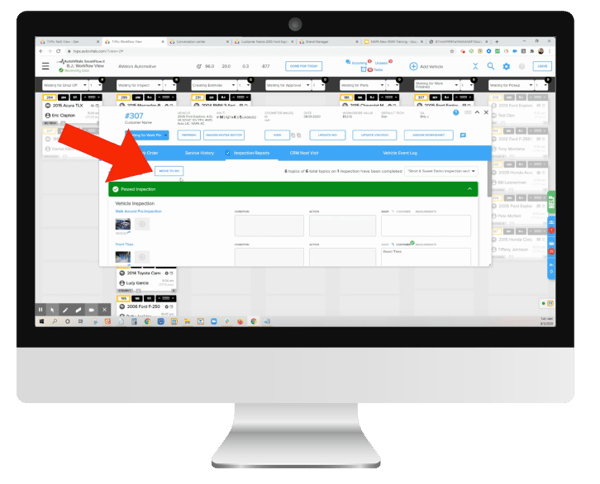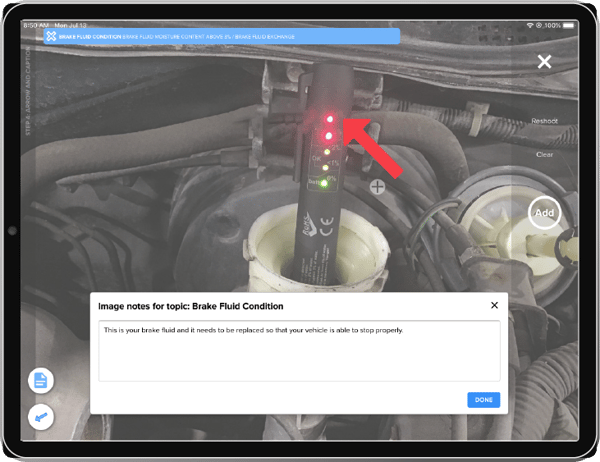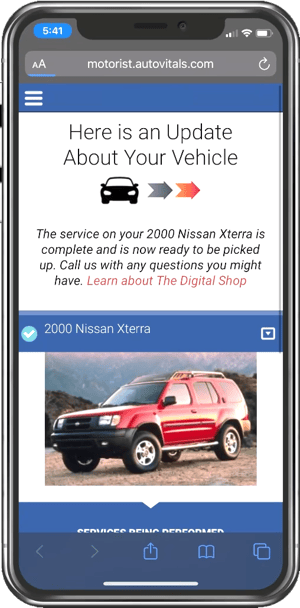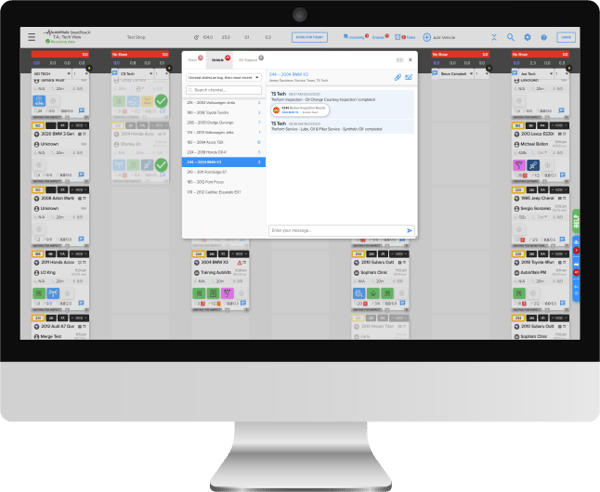The Digital Shop® Blog
Efficiency = More Revenue in 3 Steps
When you are running an auto repair shop, every minute counts. Yet, some shops are still losing more than 580 minutes a week to inefficiencies. The good news is that with three easy steps, you can find that extra 10 hours a week and increase your shop’s revenue by up to 80%.
Service advisors are some of the hardest working people in the automotive aftermarket industry. Day after day, they manage customer and technician expectations and deal with constant interruptions, all while carrying out their expected job responsibilities. Service advisors are also some of the most overworked people in the auto repair shop industry as most paper-based processes are inefficient and error-prone. Implementing digital processes and workflow not only saves time on each estimate but also utilizes time that previously was unproductive.
1. Save time building an estimate: Integrate DVI and POS
Building estimates are a large part of your service advisor's job description and there are better tools to use than pencil and paper. You might not realize how costly writing paper ROs and performing paper-based inspections are, but implementing digital vehicle inspections (DVI) with a two-way point of sale (POS) integration can save you and your team time and money.

Screenshot of a POS integration. The arrow is highlighting the ability to move things to the RO easily.
The integrated system allows all of the information from your POS to pass through your DVI recommended actions. This creates a history of declined or performed work that is immediately shared across both platforms, making it possible for your shop to get the most out of your operating systems.
Canned jobs
Additionally, with an integrated DVI and POS, you can create and save canned jobs in your system. Instead of typing in the same thing several times a day, your team can tap a few buttons quickly, selecting the canned job.
“The more canned jobs we can have, where it’s automating it and less customization by the service advisor speeds the front counter up as well. If they [service advisors] can spend less time on the technical part of just building the estimates and getting it prepared, and more time actually talking to the customer, communicating, helping them understand, the more power for them.”
- Travis Sallee, General Manager of Loren’s Auto Repair in Kalispell, Montana and DRIVE client , during an episode of The Digital Shop Talk Radio.
Guided inspections
Saving your auto technicians time also results in quicker estimates. DVIs with AutoVitals allow for guided inspections, which prevent typos and protect time. The guided inspection sheet not only provides a list of line items for the tech, it also pre-populates stock notes that address the most common issues found with that line item. For example, if the inspection shows typical wear on the tires, the text is already created, saving the tech and service advisor from having to type a caption. However, if there is something additional to note, text can easily be added or subtracted to ensure the motorist understands the condition of their vehicle.

An example of the pre-poulated text that is found with guided inspections.
2. Less time on the phone
 Attempting to write ROs, manage labor inventory, and deliver exceptional customer service while the phone is ringing off the hook makes for a frustrating and unproductive use of service advisors’ time.
Attempting to write ROs, manage labor inventory, and deliver exceptional customer service while the phone is ringing off the hook makes for a frustrating and unproductive use of service advisors’ time.
Instead of having customers call as many as five times per visit to check on the status of their vehicle, an automated customer communication system can prevent hours on the telephone. Just by implementing digital processes, your DVI system can send out text messages to motorists keeping them in the loop about their service. Notifications can include information like when the inspection started, the vehicle assessment, and when it is time to pick up the vehicle.
These automatic notifications reduce separation anxiety for motorists and give service advisors more time to audit inspections and sell work instead of soothing customer anxiety on the phone.
“A big part of that is getting that educational content into the inspection story because we’re talking about freeing up time,” said Tom Dorsey, host of The Digital Shop Talk Radio in episode 68. “We’re talking about letting your service advisor be his best self, to apply his focus where it’s going to get the best bang for the buck. Not over here, leaving messages and chasing folks on the phone and doing all this kind of stuff that we tend to do, but really editing and preparing that story and then having those educational conversations with the customer that convert them into sold hours. That’s where you want him [the service advisor] spending the bulk of his time.”
The best part? We can track how it works. In the Business Control Panel, we are able to see how long the motorist looks at each inspection.
"Being able to track Motorist Research Time has been a game-changer," said owner of Affordable Automotive in Chico, Calif. and DRIVE client Mike Button. "Sure, it's an indicator of a larger RO, but it also validates the hard work the techs and service team do on the inspection and workflow process"
3. Workflow and Task Management
It isn’t just customers who interrupt the service advisors. Technicians often walk up to the front counter to ask service advisors questions on motorist approval, parts delivery, and more, leading to idle time for everyone involved.

Save time (and steps) by using the chat function.
Turn that time running back and forth to the bays into revenue by using a workflow and task management system like AutoVitals SmartFlow.X. Not only does it make it easy to find information, since everything is in one place, it also has a chat function that saves technicians and service advisors trips to and from the front counter.
"My Service Advisors came to see how useful using the digital workflow tools were and how much easier it made their job, exceeding goals became easy," Mike said.
The system also shows service advisors what technicians are available so they can easily schedule work, check vehicle progress, and keep your shop running smoothly.
Read On
Driving Growth With Consistency in the Auto Repair Shop
“The name of this episode is what, consistent processes? We were just talking earlier, saying the...Processes: The Key to Success (Even When Your Entire Shop Has COVID)
Disaster struck Levon Arnold’s shop Long Arm Mechanics, in Garden City, Idaho, late last year when...Host Turned Guest: Tom Dorsey Joins Jay Goninen on Beyond the Wrench
Tom Dorsey, host of The Digital Shop Talk Radio, was a guest on this week’s Beyond the Wrench with...Posts by Topic
- Digital Shop (47)
- auto repair shop (44)
- automotive shop management software (31)
- Auto Shop (29)
- Autovitals (29)
- DVI (29)
- shop management (25)
- workflow (18)
- Digital Marketing (17)
- BCP (16)
- CRM (15)
- auto repair shop marketing (15)
- Staff Buy-In (14)
- Best Practice (13)
- aro (13)
- Consistency (11)
- Digital Vehicle Inspection (11)
- Process Change (11)
- Tech (11)
- service advisor (11)
- COVID-19 (10)
- KPIs (10)
- Shop Culture (10)
- Websites (10)
- AutoVitals News (8)
- Integration (8)
- Website (8)
- automotive shop software (8)
- Announcement (7)
- Automotive Technician (7)
- Press Release (7)
- Partners (6)
- auto repair marketing company (6)
- auto repair shop SEO (6)
- New Features (5)
- auto repair services (5)
- best auto repair software (5)
- Coaching (4)
- Customer Reviews (4)
- Paperless (4)
- Reviews (4)
- auto shop management (4)
- multishop (4)
- smartflow (4)
- Automotive Technician Shortage (3)
- DRIVE Shops (3)
- Digital Shop Conference (3)
- Industry Events (3)
- Meineke (3)
- NAPA (3)
- Shop-Ware (3)
- auto parts inventory (3)
- auto shop efficiency (3)
- automotive repair invoice app (3)
- creative (3)
- drop off (3)
- training (3)
- web based auto repair software (3)
- Automotive text messaging (2)
- Bookkeeping for auto repair shops (2)
- POS (2)
- Picture Edits (2)
- Protractor (2)
- Recruiting (2)
- RepairPal (2)
- TeE-Times (2)
- The Digital Shop Talk Radio (2)
- inventory management (2)
- loyalty (2)
- Auto mechanic interview questions (1)
- BayIQ (1)
- Building a Bench (1)
- Campaign Manager (1)
- Canned Jobs (1)
- Case Study (1)
- Community (1)
- GMB (1)
- Guided Inspection (1)
- Hiring (1)
- Interview (1)
- MRT (1)
- Motorist Approval (1)
- Q&A (1)
- Remote Work (1)
- Service Writer (1)
- TVP (1)
- Tekmetric (1)
- The Digital Shop Summit (1)
- Who's in our shop? (1)
- auto parts (1)
- auto repair shop financing (1)
- best auto repair shop websites (1)
- estimate (1)
- financing (1)
- inflation (1)
- marketing plan (1)
- parts catalog (1)
- pricing (1)
- retention (1)
- script (1)
- social media (1)
- social media marketing (1)



